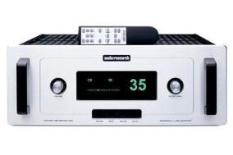What Hi-Fi? Verdict
The Reference 3 is sonic landmark, and fully deserves the ‘Reference’ tag
Pros
- +
The most convincing all-round performance we’ve ever heard from a preamp. Yes, it really is that good
Cons
- -
Price puts it out of the reach of all but the wealthiest enthusiast buyers
Why you can trust What Hi-Fi?
Unlike some other manufacturers, Audio Research never uses the term ‘Reference' lightly. In fact, it took almost two decades of making digital equipment before the company felt able to put the ‘Reference' tag on a CD player, so clearly, its Reference 3 preamp is considered by the company to be something rather special. After a good long listen, we have to agree.
As you might hope given the price, this is a decently equipped, valve-powered line–level preamplifier: it features a full complement of balanced and single ended connections, and even has remote control.
However, there are some unusual touches: that large display almost looks comical at first, but with longer acquaintance, you appreciate just how easy it is to read at a distance, even in a brightly lit room. Press a button on the rather basic remote and it shows how long the unit has been used, which is handy for keeping tabs on valve life.
Audio Research claims the valves should be good for around 4000 hours and, as always, uses commonly available tubes to ensure spares for decades to come. This is no hype: the company can still service its products from the 1970s, when it was founded.
A realistic, positive sound
So, how does the Reference 3 sound? In a word, magical. As you'd expect, it reveals a mass of detail, but the real pleasure is in the way it arranges this to make any recording sound more lifelike. Many top-end products are unforgiving of below-par discs: they'll emphasise the flaws rather than searching out the good.
The Reference 3, for all its insight and clarity, always accentuates the positive. Yes, you'll be well aware of everything that's wrong with the disc, but you'll also hear everything that's right with it, too.
Voices sound as real as we've heard on any preamp, which is a real treat when listening to awe-inspiring talents like Nina Simone or Frank Sinatra. And a lot of that is to do with the impressively expressive dynamics.
A supreme communicator
With an appropriate power amplifier – we used Audio Research's Reference 210 monoblocs and Bryston's 4B SST – large-scale crescendos have the ability to surprise: you'll actually blink when a powerful transient strikes. Perhaps more importantly, this preamp is supreme at communicating the finest nuances of music – the microdynamics as well as the big stuff – that define the emotion in an instrument or voice.
We could go on about the Reference 3's ability to define the body and decay of a note better than anything else we've heard. We could rave over its skill in unravelling a busy mix so you can follow each musical strand with ease. We could even eulogise the expansive soundstage it delivers. But we think you get the idea by now. We've fallen for this preamp big time.
What Hi-Fi?, founded in 1976, is the world's leading independent guide to buying and owning hi-fi and home entertainment products. Our comprehensive tests help you buy the very best for your money, with our advice sections giving you step-by-step information on how to get even more from your music and movies. Everything is tested by our dedicated team of in-house reviewers in our custom-built test rooms in London, Reading and Bath. Our coveted five-star rating and Awards are recognised all over the world as the ultimate seal of approval, so you can buy with absolute confidence.


